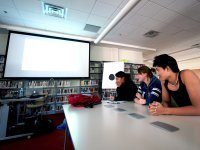Lights, Cameras, Teach! Movie Making as a Lesson Planning Strategy
Check out these seven ideas for bringing the creative juices of movie making into your teaching practice.
Your content has been saved!
Go to My Saved Content.I've always been a movie fan. Movies don't just entertain; cinema and television determine the way we see the world. From the personal dramas of our love life to heroes and villains on the world stage, the quest to find personal fulfillment and meaning in the world has largely been shaped by the industry we call "Hollywood."
Cinema can also be a fun and useful model for lesson planning. It offers a tried-and-true structure for engaging an audience of moviegoers that can be equally effective with a classroom full of students.
In the Classroom: Action!
Here are seven ideas for bringing the creative juices of movie making into your teaching practice:
1. Use a Three-Act Story Structure
Let's be honest, no matter how big your budget might be or the talent of your students and the teacher, walking onto the set without a tight script will not bode you well. Your lesson plan is your script.
Like any good script, it works on a three-act story structure:
- The first act: the setup
- The second act: the introduction of a problem (or conflict) followed by rising action and leading to a climactic moment
- The third act: defined by falling action and a resolution
All good lesson plans have a good set up. I like to start mine with slide shows and lectures relating to the theme, history, and larger context that defines that particular unit. Then, I throw it back to the students: Now you can do this yourselves!
This initial excitement of the first act leads to the second act: the crisis. Can they actually do what you've asked them to do? With good planning, any overwhelmed student can have that climatic moment of achievement or failure, both which are valuable for the student to experience.
Resolution and conclusion are important, and this can take the form of reflections or sharing the work with a wider audience. Often, it is only at the conclusion that we really get the point of the lesson.
2. What's the Elevator Pitch?
The elevator pitch is how one sells one's movie idea in the time it takes to have a short elevator ride with a possible funder. But really, you need to first sell the idea to yourself, a colleague, or your students. This is not just an exercise in persuasion; it's more about explaining your idea in the most concise and compelling way. When that is hard to do, that means your lesson still has to go through some necessary revision.
3. The Classroom Is Your Set
How does your classroom serve as a set? Where does the action take place? What props do you need to teach? What alterations must you do so that the action works throughout the lesson?
4. On Location: The Importance of Field Trips
At times, your movie set -- your classroom -- no matter how hard you try to create an immersive, hands-on experience, ends up being limiting. No special effects or fake backdrops can take the place of the real thing. Taking your students out and about brings both real-world content and ambience to your teaching.
5. Stunt Doubles
No matter how good you are at teaching or understanding the breadth of your discipline, sometimes it is necessary to bring in outsiders to do the things you can't do or are unwilling to do yourself. This also shakes things up for you students in a good way. When I teach students about graffiti artists, I find that it really helps to have hands-on demos by professionals who come from the community.
6. Special Effects
Special effects are not just adding bells and whistles to your lesson plan, but are the essence of cinema and good teaching. Your job as a teacher is to make abstract ideas real to your students and to bring your subject to life. And like all good special effects, they should serve the story you are trying to tell. If your performance and planning are solid, the special effects -- be that the interesting anecdote, the demo, or the gestures you use while you are lecturing -- are what you need to help your students experience the wonders and the depths of your subject.
7. Cliffhangers
Just seconds before I dismiss my students, I sometimes pose the most challenging question to them or present the most puzzling material. If students are puzzled or flummoxed and want immediate resolution, then all the better; I tell them they'll find out next class.
So, as a cliffhanger question, how has cinema influenced the way you teach? Please share in the comments section below.
